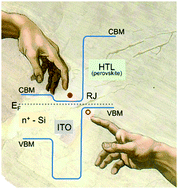Recombination junctions for efficient monolithic perovskite-based tandem solar cells: physical principles, properties, processing and prospects
Abstract
Crystalline silicon (c-Si) solar cells comprise more than 95% of the photovoltaics (PV) market. At wafer-scale, this technology is gradually reaching its practical power conversion efficiency (PCE) limit. Therefore, new performance-driven and scalable alternatives must be developed to further increase the cost-competitiveness of PV. Stacked PV absorbers with decreasing bandgaps in a tandem configuration utilize more efficiently the solar spectrum, and can thereby overcome the single-junction efficiency limit of conventional solar cells. Specifically, the monolithic, two-terminal tandem solar cell implementation promises a simple, yet high-performance technology with high market-relevance. Metal-halide perovskite absorbers have attracted broad interest in their application as the top cell of such a c-Si based tandem solar cell configuration. Practically, the perovskite and c-Si subcells need to be electronically coupled, where the interfacial structure should guarantee efficient charge recombination of majority carriers (collected from each subcell), without inducing minority-carrier recombination. In this article, we review the mechanism underlying efficient recombination junctions, and discuss available materials systems for perovskite-based tandems, as well as additional requirements such as efficient light coupling into the subcells, processing compatibility, scalability of materials and methods, and stability. We extend our discussion beyond c-Si to thin-film bottom cell technologies such as low-bandgap perovskites and chalcogenides. We conclude with an outlook on considerations for industrialization of such interfacial structures.

- This article is part of the themed collection: Horizons Community Board Collection: Solar Energy Conversion


 Please wait while we load your content...
Please wait while we load your content...